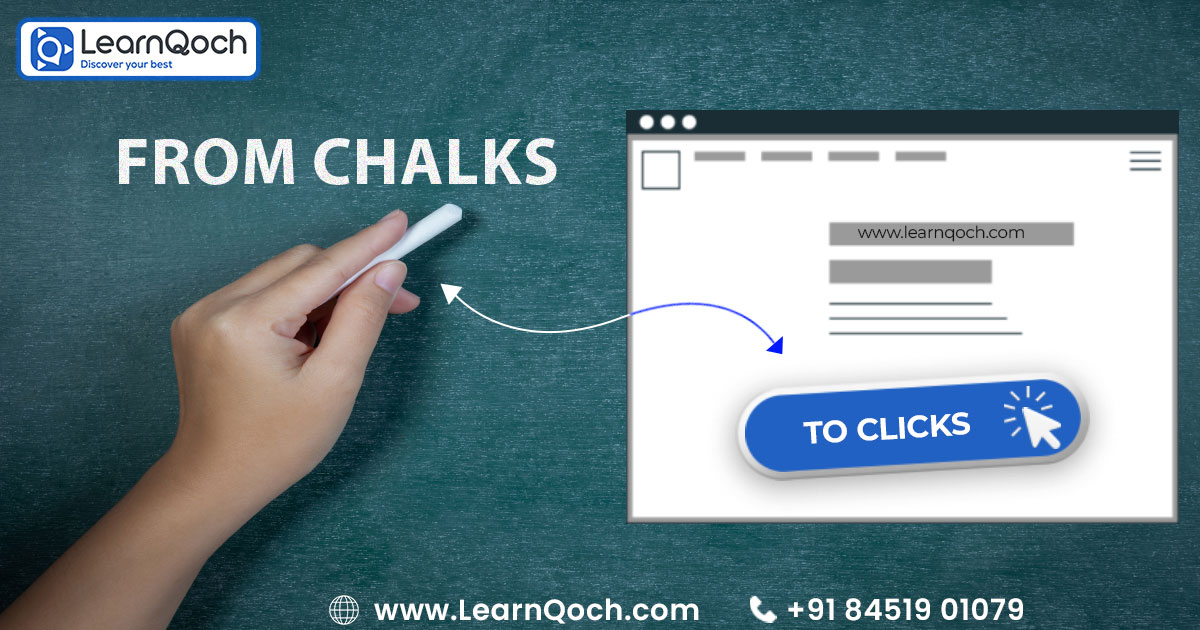The Digital Transformation of Education: From Chalk to Clicks
Education has always been a dynamic field, constantly evolving to adapt to the changing needs of society. However, the 21st century has witnessed a transformation like no other, with the advent of digital technology redefining the way we learn and teach. In this blog, we will take you on a journey through the digital transformation of education, from the chalkboard era to the era of clicks and online learning. We will also explore how integrated ERP (Enterprise Resource Planning) and LMS (Learning Management System) software like LearnQoch are playing a pivotal role in this educational revolution.
The Chalkboard Era
Not too long ago, classrooms were dominated by chalkboards, textbooks, and overhead projectors. The teacher was the sole source of knowledge, and learning was confined to the physical classroom. Students took notes in notebooks, and communication between teachers, students, and parents was primarily through handwritten notes or face-to-face meetings. While this traditional model of education served its purpose for many years, it had its limitations.
- Limited Interactivity: Chalkboard teaching lacked interactivity, with students primarily passive listeners, missing out on hands-on learning experiences.
- Lack of Visual Aids: Chalkboard teaching offered limited visual aids, making it challenging to convey complex concepts effectively.
- Minimal Accessibility: Educational resources were confined to physical classrooms, limiting access for remote or differently-abled learners.
- Time-Consuming Corrections: Grading and feedback were time-consuming, leading to delayed assessment and feedback for students.
- Communication Barriers: Communication between teachers, students, and parents relied on handwritten notes and face-to-face meetings, hindering real-time updates and parent involvement.
- Limited Resources: Chalk and blackboards had finite space and limited resources, restricting the scope of lessons and materials that could be shared.
The Digital Transformation Begins
The dawn of the internet and the rapid advancement of digital technology changed the landscape of education dramatically. The transition from chalk to clicks brought about a multitude of benefits, making education more accessible, interactive, and efficient.
- Online Learning: The introduction of computers and the internet paved the way for online learning platforms. These platforms offered a wealth of educational resources, from video lectures to interactive quizzes, available at the click of a button. Students could now access information and study materials from anywhere, breaking down geographical barriers.
- Interactive Learning: Digital technology allowed for the development of interactive educational software and applications. These tools transformed passive learners into active participants, engaging them in immersive learning experiences. Concepts that were once abstract could now be visualized through animations, simulations, and virtual labs.
- Personalized Learning: With the help of data analytics, digital platforms could tailor learning experiences to individual student needs. Adaptive learning algorithms could identify a student’s strengths and weaknesses, providing personalized recommendations for study materials and pacing.
- Instant Feedback: Grading and feedback processes were expedited with digital assessment tools. Teachers could provide timely feedback, helping students to learn from their mistakes and improve faster. This immediate feedback loop was a game-changer in the learning process.
- Global Collaboration: The digital era enabled students to collaborate with peers worldwide. Video conferencing, discussion forums, and online group projects brought diversity and global perspectives into the classroom, enriching the learning experience.
- Enhanced Communication: Communication between teachers, students, and parents became seamless through emails, online messaging systems, and dedicated portals. Parents could now actively monitor their child’s progress, and teachers could share updates and resources effortlessly.
- Resource Abundance: The digital realm removed the constraints of physical space and resources. Educational content, including textbooks, research papers, and multimedia materials, became abundantly available online, reducing costs and expanding the horizons of learning.
LearnQoch is a cutting-edge integrated ERP (Enterprise Resource Planning) and LMS (Learning Management System) software that is revolutionizing the way educational institutions operate and deliver learning experiences. It seamlessly combines the power of administrative management through ERP with the dynamic capabilities of online learning and course management through LMS.
LearnQoch streamlines administrative processes, including admissions, enrollment, finance, and resource allocation, while also providing a robust platform for educators to create, manage, and deliver courses and content. This integration empowers educational institutions to efficiently manage their operations, enhance the learning experience for students, and harness valuable data insights for continuous improvement.
LearnQoch is a comprehensive solution that caters to the diverse needs of modern educational institutions, making it a pivotal tool in the digital transformation of education.
Find a bridge to greater success with LearnQoch.
Call us at +91 84519 01079 or email at info@learnqoch.com
Also, read,

